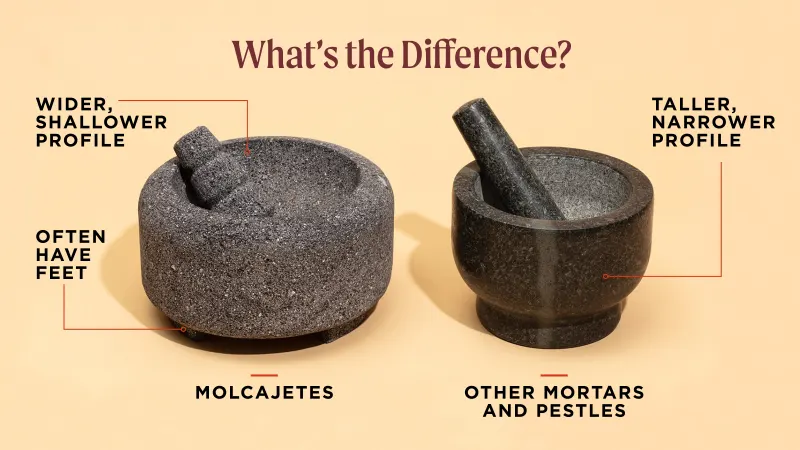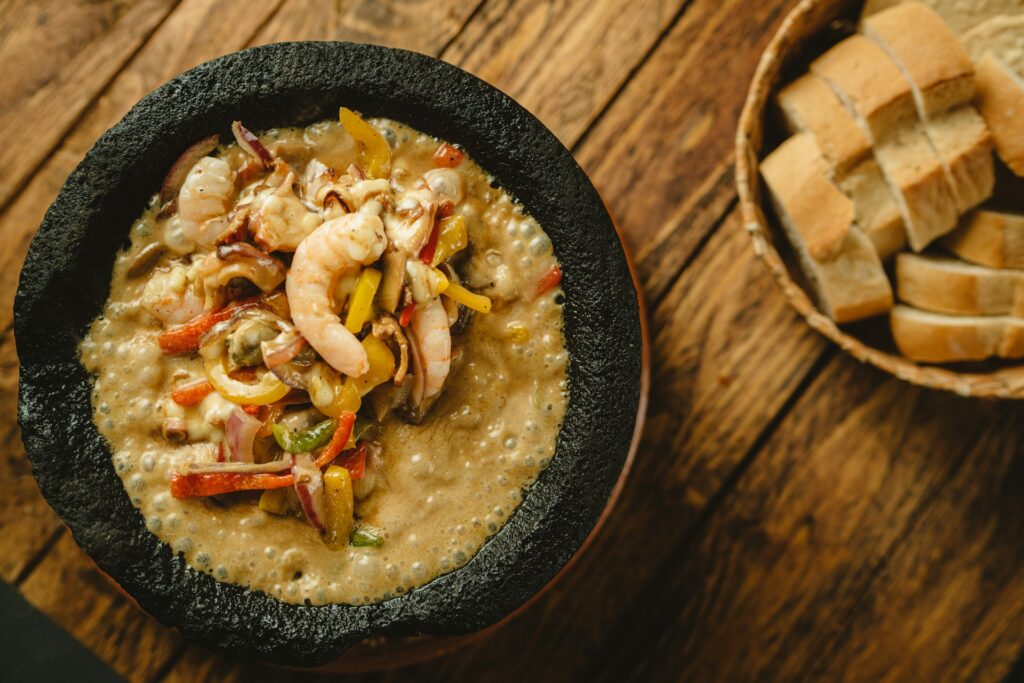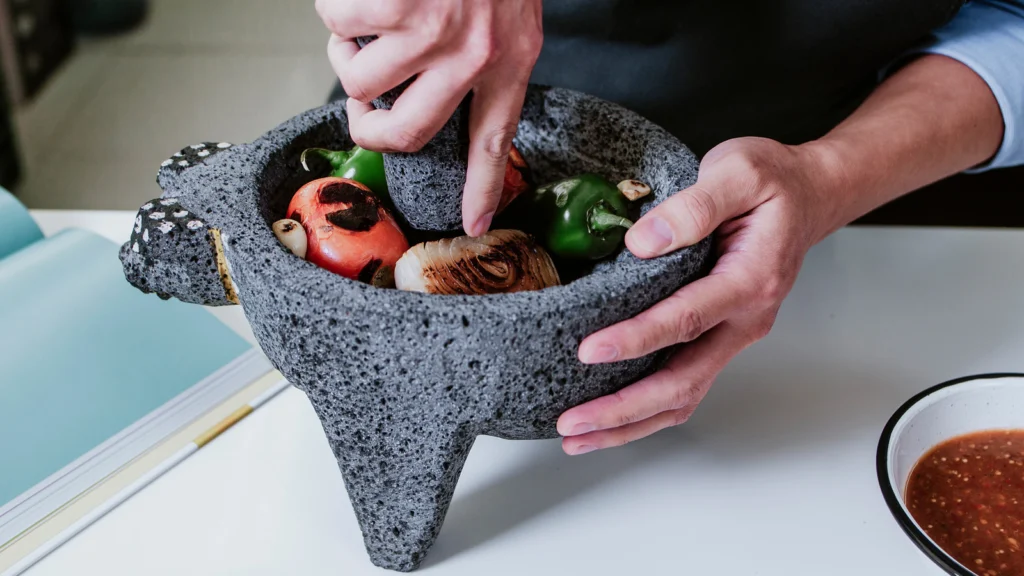In the world of culinary arts, few tools are as versatile and essential as the Molcajete. Originating from Mexico, this traditional kitchen implement has withstood the test of time, embodying a rich history and unmatched functionality. From grinding spices to creating flavorful sauces, it serves as a cornerstone of Mexican cuisine, elevating dishes with its unique texture and depth of flavor.
Understanding the Molcajete: A Symbol of Tradition
The Molcajete, typically made from volcanic rock such as basalt, features a sturdy mortar and pestle design. Its rough surface allows for efficient grinding and blending of ingredients, imparting a distinct taste and aroma to every dish. Historically, it has been used by generations of Mexican families, symbolizing the cultural heritage and culinary traditions of the region.
History
The story of the Molcajete traces back to ancient Mesoamerican civilizations, where indigenous peoples crafted these tools from volcanic rock. The word “Molcajete” itself finds its origins in the Nahuatl language, spoken by the Aztecs, translating to “sauce bowl.” This humble yet versatile tool became indispensable in grinding and mixing various ingredients, laying the foundation for the bold flavors of Mexican cuisine.
Types of molcajetes
There are different types of molcajetes used in Mexican cuisine, each with unique characteristics and purposes:
- Traditional Molcajete: Carved out of a single block of vesicular basalt, traditional molcajetes are typically round and supported by three short legs. They are often decorated with the carved head of an animal on the outside edge of the bowl, such as a pig, giving them a distinctive appearance.
- Imitation Molcajetes: While true molcajetes are made of basalt, imitations are sometimes made of a mixture of pressed concrete and volcanic rock particles. These imitations may not offer the same grinding quality and flavor retention as authentic basalt molcajetes.
- Molcajete Menu Items: In modern Mexican cuisine, molcajetes are also used as serving dishes for various dishes like Molcajete Camarones (shrimp simmered in tomato sauce), Molcajete Mariscos (featuring grilled scallops, shrimp, and fish in tomato and cheese sauce), Grilled Chicken or Steak options, and Molcajete Ultimo (a mix of shrimp, grilled chicken, and steak slices with peppers and onions).
- Variations in Material: Molcajetes can be made from volcanic rock or granite. Traditional molcajetes made from volcanic rock have a rough surface that aids in grinding spices effectively. On the other hand, granite mortar and pestles are more durable but may not provide the same flavor-enhancing qualities as volcanic rock molcajetes.
- Metate: While not a type of it, metate is another essential tool in Mexican cuisine. It is a flat grinding slab made from basalt stone used with a mano (pestle) to grind cooked corn kernels into masa for making corn tortillas

Differences between a molcajete and a Tejolote
The molcajete and tejolote are stone tools used in Mexican cuisine, serving as the traditional Mexican version of the mortar and pestle. Here are the key differences between a molcajete and a tejolote:
- Molcajete: It is a bowl made of rough stone, typically round, supported by three legs. It is used for grinding various food products like spices, salsas, and guacamole
- Tejolote: The tejolote is the hand-held grinding tool that accompanies the molcajete. It is made of the same basalt material as the molcajete and is used to grind ingredients within the molcajete.
In summary, while it serves as the bowl for grinding food products, the tejolote acts as the pestle used to crush and grind ingredients within it. Together, they form a traditional Mexican mortar-and-pestle set used for various culinary purposes in Mexican cuisine.
Versatility in Culinary Applications
Grinding Spices and Herbs
One of the primary functions of the molcajete is the grinding of spices and herbs. From cumin seeds to garlic cloves, the coarse surface of it ensures that ingredients are crushed and blended to perfection, releasing their essential oils and flavors. This process not only enhances the taste of dishes but also adds a rustic charm to the cooking experience.
Making Authentic Sauces and Salsas
In Mexican cuisine, sauces and salsas play a vital role in adding depth and complexity to dishes. It excels in the preparation of these flavorful accompaniments, allowing cooks to blend ingredients such as tomatoes, onions, and chilies to create mouthwatering sauces. Its rough texture imparts a unique consistency to sauces, resulting in a truly authentic taste experience.
Crushing Fruits and Vegetables
Beyond spices and sauces, it can also be used to crush fruits and vegetables, making it a versatile tool in the kitchen. Whether preparing guacamole or mashing avocados for a salad, the molcajete offers superior control and texture compared to modern alternatives. Its manual operation allows cooks to customize the consistency of ingredients according to their preferences, resulting in perfect results every time.
Heating and Serving Dishes
It can be heated to high temperatures using an open fire or hot coals, then used to serve dishes like Molcajete Camarones (shrimp simmered in tomato sauce), Molcajete Mariscos (featuring grilled scallops, shrimp, and fish in tomato and cheese sauce), or Grilled Chicken or Steak options. The high thermal mass of the molcajete keeps dishes hot for a long time, making it a unique serving vessel.
Enhancing Flavor and Texture
The use of a molcajete is all about enhancing flavor and texture in dishes. The rough surface creates uneven textures that build on each other, releasing more flavors and oils compared to cutting ingredients. Molcajetes also retain flavors and oils over time, like a seasoned pan, adding depth to the food prepared in them.

Cleaning and maintenance of molcajete
To clean and maintain a molcajete, follow these steps:
Cleaning Process
Initial Cleaning: Wash it with a stiff kitchen brush and water to remove any stone dust. Let it dry thoroughly.
Pulverize Rice: Place half of the rice into the mortar and grind it in circular movements with the tejolote until completely pulverized. Repeat with the remaining rice until the powder is white.
Add Ingredients: Peel garlic cloves and place them in the molcajete along with cumin, salt, and pepper. Grind all ingredients around the entire basin, then rinse with warm water and let it dry completely before storing.
Maintenance Tips
After Each Use: Rinse your molcajete with warm water after each use. Avoid using soap, as the stone can absorb it and transfer it to your food.
Drying: Always ensure that your molcajete is completely dry before storing it to prevent mold or mildew growth.
Sanitizing: To sanitize your molcajete, place it in an oven set at 350°F for 20 minutes. This helps eliminate any bacteria or odors.
Remember not to clean your molcajete in the dishwasher, as this can damage the stone. By following these cleaning and maintenance steps, you can keep it in good condition for long-lasting use in preparing delicious salsas, guacamole, and other dishes.
Frequently Asked Questions
What materials are Molcajetes made of?
Molcajetes are typically crafted from volcanic rock, such as basalt or granite, and are prized for their durability and ability to impart unique flavors to dishes.
How do I season a Molcajete?
To season it, grind a mixture of rice and water until the paste becomes smooth. Rinse thoroughly, then repeat the process with garlic and salt. This helps remove any grit and imparts flavor to the stone.
Can I use a Molcajete to grind spices?
Yes, they are excellent for grinding spices, herbs, and seeds. The coarse surface texture ensures uniform grinding, releasing the full aroma and flavor of the spices.
Is a Molcajete difficult to clean?
Cleaning a Molcajete is straightforward. Simply rinse with warm water and use a brush to remove any stubborn residue. Avoid using soap, as it can impart unwanted flavors to future preparations.
Can I use a Molcajete to make guacamole?
Absolutely! Molcajetes are renowned for producing exceptional guacamole. The coarse texture of the stone helps blend the ingredients while retaining the desired chunky consistency.
Where can I purchase a Molcajete?
Molcajetes are readily available at specialty kitchen stores, online retailers, and Mexican markets. Look for ones made from authentic volcanic rock for the best results.
Conclusion
In the bustling kitchen of Mexican gastronomy, the Molcajete stands as a symbol of tradition, flavor, and craftsmanship. As culinary enthusiasts continue to explore the rich tapestry of Mexican cuisine, this humble tool remains a timeless companion, unlocking the secrets of authentic flavors and culinary creativity.

